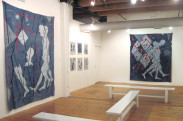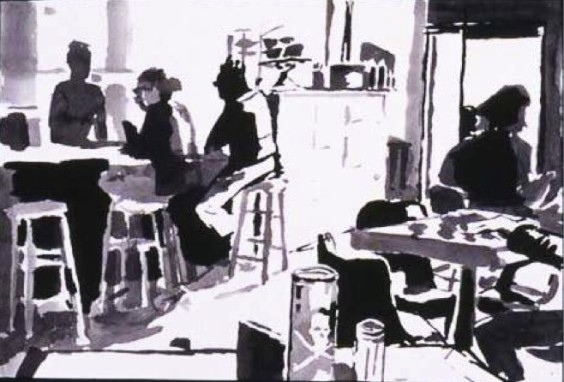
by Alessandra Stamper

Jinx wasn’t the first coffeeshop I spent serious time in but it was the one that mattered most. I hung out there almost daily from 1998 to 2000. When I wasn’t at work or at home I was at Jinx. Many mornings started with a walk from my place, just past the Clemente High School baseball field, east down Division to the coffeeshop. I’d walk back west in the late afternoons, so jacked up after 5 or 10 cups of their coffee that I felt like bursting out of my skin and flying the rest of the way home.
Jinx opened in 1997 just in time to fill the vacuum made by the closing of Urbus Orbis at the end of that year. A victim of the gentrification it helped pave the way for in Wicker Park, Urbus sent its orphaned regulars south down Damen to Division, where the place with the black cat logo welcomed them in with, if not open, then at least tolerating arms. Jinx wasn’t the kind of place that would come out and tell you it liked you. But the coffee was really fuckin’ strong and the toaster-oven worked most of the time and that was good enough for most of us most at the time.
The reasons people spend time in coffeeshops are complicated. Nowadays they function as workplaces for many of us but in the late ’90s that wasn’t the case. To be sure, some early internet geniuses were already laying the groundwork for their empires while getting overcaffeinated at places like Jinx, but most of us were there for much less focused, less careerist reasons. Some had more time than they knew what to do with, others needed an audience in order to hold forth, but most were just lonely and happy for whatever human attention was available.
Unlike the hippie/bohemian vibe of Urbus, Jinx had a mod/retro thing going. There was a pinball machine and scooter clubs met up there. Aesthetic choices were made. Jason and Michelle had a vision. Everyone that opens a coffeeshop does. It’s rarely a business proposition. You rent a storefront and decorate it with all the things you love and get your friends to come over and hopefully make new ones to create the community you imagine or yearn for. Most of these places don’t end up breaking even. It’s not why they’re there.
I was 27 then. I delivered Thai food to pay the bills and painted the rest of the time. Many of the employees and regulars at Jinx would order from my restaurant. I saw the same group of people all the time. Albert introduced me to his girlfriend, Rachel, because she hadn’t made any friends since they’d moved to Chicago from California. She was working at Leo’s down the street. We’d end up living together later. Our relationship would help wreck both my marriage and hers, though we were never a couple.
Jinx was where I pined for my future ex-wife and where I tormented my now-girlfriend as she tried to prepare for the art survey class she was trying to teach at the Art Institute. I’d wander over and tell her all the artists she was interested in were shit. These were unsolicited opinions made worse—she told me years later—by the fact that I reeked from rarely bathing.
It was where I watched Mike struggle obsessively with his band’s website, teaching himself how a computer worked from the ground up, then abandoning the whole thing without showing anyone all the work he’d done, just when he’d figured it all out. I’d sit with Bud as he stared through the paperback he’d brought to read, rarely turning its pages. I’d watch Sid play chess and occasionally would play myself, though I knew by then that I’d never get better without studying and I had no intention of studying. Most of the time I didn’t talk too much but watched and painted.
Gangbanger kids used to come in to play the pinball machine. They’d come over sometimes and watch over my shoulder as I worked. The art and music types acted like they were cool with them but were mostly terrified. These kids were from the neighborhood while most of the rest of us were new to the neighborhood. One day one of them came over and asked if I’d paint his portrait. He offered me $10. All of his friends crowded around the booth as we sat across from each other. Everyone else in the place didn’t know what to make of it. They gave us a wide berth. When the picture was done the crowd dispersed. Him and I would acknowledge one another with a knowing nod for years after.
Most of the people who worked at Jinx were trying to be musicians or artists or filmmakers or something in between. They’d play their own music on the stereo along with the music they loved. There was a lot of French pop, Scott Walker and Radiohead’s Ok Computer on repeat. They were all younger than me. It was the first time when I felt like the old guy. Not fitting in was by then a matter of course but up until then it wasn’t due to age. Many of my fellow regulars were in an in-between stage as well. For most, the realization that their first love—be it writing, music, whatever—wouldn’t pan out, was just beginning to set in. Some were in the process of hatching back-up plans, others just sat there not knowing what their next move might be. Most were caught in that transitional moment between dreams dying and reality setting in. I watched artists turning into doctors and guitar players turning into lawyers but just kept painting. I couldn’t see a way out the way they did.
By 1999 I had enough pictures of Jinx for a whole show. I spent weeks at the Great Frame-Up assembling moldings, mattes and glass, then shipped a couple dozen paintings east. My father arranged for an exhibition at MIT where he worked. I wrote a bunch of high-minded claptrap for the show description that’s better off forgotten. All this time later what I can say is that Jinx was a great place to watch and listen to people. They’d come and go while I’d keep sitting there, blending into the background. The best way I know to make art is to get out of the way and take the world in. It’s about what’s out there rather than anything inside me. Perhaps that’s why a coffeeshop makes for such an ideal setting. It’s public enough to capture a whole scene yet private enough to notice the odd intimate moment. We all lose ourselves from time to time..often around the 6th or 7th cup of coffee.
Jinx has been gone for many years but I still see Jinx people around Chicago. Baristas became bartenders and regulars found other coffeeshops to haunt but the place at Damen and Division with the black cat sign over the door has etched out a little corner in our collective memory.
Goddamn was that coffee strong…
Dmitry Samarov paints and writes in Chicago, Illinois. He has exhibited his work in all manner of bars, coffeeshops, libraries, and even the odd gallery (when he’s really hard up). He is the author of the illustrated work memoirs Hack: Stories from a Chicago Cab (University of Chicago Press, 2011) and Where To? A Hack Memoir (Curbside Splendor, 2014). He no longer drives a cab.
click to see who
MAKE Magazine Publisher MAKE Literary Productions Managing Editor Chamandeep Bains Assistant Managing Editor and Web Editor Kenneth Guay Fiction Editor Kamilah Foreman Nonfiction Editor Jessica Anne Poetry Editor Joel Craig Intercambio Poetry Editor Daniel Borzutzky Intercambio Prose Editor Brenda Lozano Latin American Art Portfolio Editor Alejandro Almanza Pereda Reviews Editor Mark Molloy Portfolio Art Editor Sarah Kramer Creative Director Joshua Hauth, Hauthwares Webmaster Johnathan Crawford Proofreader/Copy Editor Sarah Kramer Associate Fiction Editors LC Fiore, Jim Kourlas, Kerstin Schaars Contributing Editors Kyle Beachy, Steffi Drewes, Katie Geha, Kathleen Rooney Social Media Coordinator Jennifer De Poorter
MAKE Literary Productions, NFP Co-directors, Sarah Dodson and Joel Craig